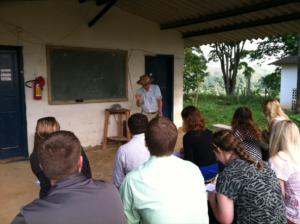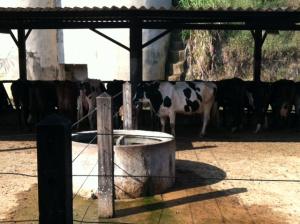By Hope Wentzel, Virginia Tech and Ethan Giebel University of Wisconsin – Platteville
Our early morning bus naps lasted only until hills planted in orderly rows of eucalyptus began flashing by. Alfredo explained that this nonnative tree can be harvested five or six times for various products from timber to essential oils. Depending on the density of the stand, crops, such as soybeans or coffee can be grown between the rows. This method is another example of agroforestry, which we discussed yesterday in the context of research in the dairy industry.
Got Milk? Brazil does! The first visit of the day was conducted at the Embrapa dairy research farm. While on the 1,030 hectare farm, we took a firsthand look at the dairy industry in Brazil. About 45% of the farm is forest land with the balance of acreage under till and pasture. Dairies in Brazil use a pasture based system with harvested forages as a supplement. Several tropical grasses that originate from Africa are used throughout Brazil as forage that is stored and grazed upon by cattle. Research is done on forage at this location in addition to the dairy cattle.
The Embrapa research facilities try to simulate normal industry conditions in order to provide research that will benefit farmers who have dairy operations. The facility we saw was one of five milking stations on the premises. It had a double four swing herringbone parlor to milk cows in. Corn silage was stored in a pair of silos and was fed in a fence line bunk to the dairy cows. The cows were Holstein crossed with Gir cattle. These cattle are bred specifically for high production in a tropical climate.
At the same location, we saw how heifer calves are raised. The calves were tied on individual huts and kept on a grassy area. Calf and cow health is a priority on the farm. This was apparent from the housing methods and practices used on the farm. Real milk is used to feed the calves in a cost effective and healthy manner. At 90 days, the calves are weaned into a group pasture. Here, the calves will reside with cattle of their size. The pasture based system allows the cattle ample airflow and plenty of room to move freely.
It was fascinating for us to compare the dairy industry and research in Brazil with that of our own systems in the United States. We saw many similarities in the industry and were very impressed with the research and practices being conducted at their laboratories as well as the farms. Currently, Brazil is the sixth largest producer of dairy in the world. It is our belief that Brazil’s robust dairy industry will continue to grow in order to supply people in the global market with the dairy products they need and love.
Our next visit of the day was to Pif Paf, the largest poultry complex in the state. This was our first exposure to the poultry and swine industries of Brazil. Although we could not actually tour the facilities due to biosecurity, the presentation, informational video, and question and answer time with the veterinarian was incredibly informative. Much like the U.S., the swine and poultry industry are vertically integrated, with producers raising the animals under contract. Many of the challenges of production, such as the cost of corn, soybeans, and labor, were similar to those experienced in the U.S. The veterinarian also discussed the difficulty of having only thirty percent of the poultry houses environmentally controlled. Hearing about the challenges Brazil’s industry us facing enabled our group to better understand our own industries and the global market.



